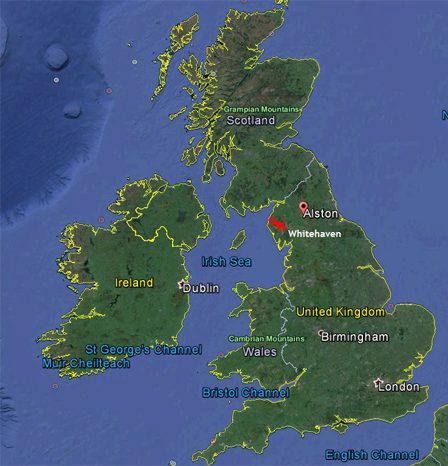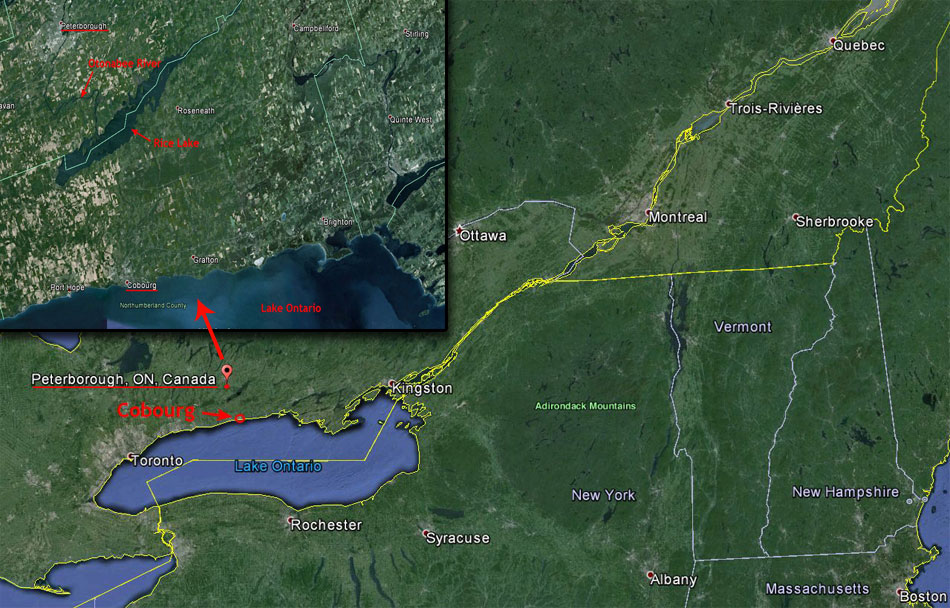The Dixon family’s journey to Peterborough
William Dixon and his family were passengers aboard the maiden voyage of the Brigantine “Jason”. They departed from Whitehaven, England and disembarked at Quebec. The family travelled to Cobourg by boat, then from Cobourg to Rice Lake by oxen. There, they built flat-bottom boats and proceeded up the Otonabee River to Peterborough. They arrived about 1818.
Emigration Scheme, Alston England
Article by Elwood Hugh Jones, Professor Emeritus of History at Trent University

The first emigration scheme was the 1818 emigration of the Colony Settlers or the Cumberland settlers. This was a community organized venture that centred around Alston, England, the highest town in England. Alston was a commercial centre of the Alston Moor, an area of fine mixed agricultural land. Many of the farmers and their sons were employed in a widespread lead mining operation that had links across northern England. Alston was close to Hadrian’s Wall and the Roman fortifications along its length, and was only 60 miles from Scotland.
Of particular interest to Peterborough, I have spent more than 10 years tracking down information about who placed the St. John’s Church tower clock that was visible over Peterborough’s downtown from 1839 to 1882, and whose works are part of the church’s archives. After years of following leads that took me to Alston in 2009, and to the towns of Hexham, Newcastle and Whitehaven, all within sixty miles of Alston. Alston was a major clock-making town, with at least five clock-making families that operated over several generations. One of these families was the Waltons, which was also directly related to the Cumberland settlers of 1818.
As I have discussed on other occasions, Thomas Walton Milburn (1809-1896) seems to be the link between the church and the clockmakers of Alston, and the clock that was in our church tower had an earlier life in the former parish church of Alston, and in Stannington, near Newcastle. While removed from its towers, the clock likely reposed in the Walton clock works. The clock remains a significant artifact, and holds secrets that might never be revealed. In the course of my wanderings I have concluded that large wooden tower clocks are very rare after the sixteenth century, and no one who has seen this artifact has seen anything comparable. But I digress.
The Cumberland settlers sailed on the Jason from the port of Whitehaven in May 1818, only a week or so after it had been built. The ship sailed to Quebec City with 110 passengers, of whom 102 had come from Alston and its suburbs. The road to Whitehaven is mostly downhill, steeply to Penrith, and more gently to Whitehaven, a distance of about sixty miles. Even now, the road seems dangerous, but in 1818 it was a well-established route joining the commercial interests of Alston and Whitehaven, and providing the key distribution route for the lead mined near Alston. The lead mining did not harm the pastoral appearance of the moor as the mines were reached by shafts, and the miners then moved parallel to the surface. Alston, both moor and town, was effectively undermined by the various tunnels and around 1780 the church tower of the earlier St. Augustine’s Church sank; the subsequent church, still standing, never had a clock tower.
This search for the clock specialist in Peterborough leads to Thomas Walton Milburn who emigrated in 1831 or 1832, joining his family after completing his education in Alston.
The Cumberland settlers had written to the Colonial Office asking for help in settling a group of some sixty settlers in Canada. The British government agreed to give 100 acres to each adult male member of the group, and to refund the settlement duties if they made improvements within five years of reaching their land. The group traveled from Port Hope mostly by water, as there were no roads until the 1840s; the women and children stayed in Port Hope until 1819, and the men established a group home on the triangle that is still evident at the base of the Communication Road, now known as Chemong Road. After the winter they helped each other to build their first homes, shanties or small log cabins, on their respective 100 acre lots which stretched along Communication Road for a few miles.
An historical stone monument was erected around 1992 by members of the Peterborough Historical Society working with Smith Township Historical Society. Gerry Stephenson was the lead volunteer on that project. The names engraved on the imposing stones were those of William Dixon and five sons; Joseph Lee and two sons, John and George; John Smith and one son, Joseph; Robert Milburn; Thomas W. Milburn; Robert Walton; John Walton; Margaret Stephenson; John Smith and Walton Wilson. The monument is clearly visible to motorists on Parkhill Road as they cross the crest of the Smithtown hill at Stewart Street, immediately across the road from the site of the first winter group home.
The Thomas W. Milburn on the stone was apparently not the one that came in 1831. However, it was interesting to learn that the Cumberland Settlers came over a period of some 25 years. This differs from chain migration in which subsequent immigrants come to areas settled by friends, neighbours and family because the initial plan included the idea they would come after completing their education. It is clear that the first years were very tough. The Dixons ran a sawmill using lumber from the immediate forest in what has since become Jackson’s Park. The area had stone quarries by the 1830s on both sides of Parkhill near Monaghan. The commercial centre developed a mile to the south in Peterborough, which became very significant to the wider area after the Peterborough Robinson settlers from Ireland in 1825. In the intervening seven years, they must have lived off the land and depended for most supplies coming from Cobourg or Port Hope. Several settlers and their children died during the first ten years of the settlement.
When the Cumberland Settlers arrived in Smith Township in 1818, they were the first European settlers in the area north of Rice Lake. Settlement was opened after a British treaty with the First Nations. It remains a mystery as to why the Colonial Office chose to settle them on such virgin land, but it appears to be connected with Upper Canadian ideas that the War of 1812 made it essential to develop and protect the waterways that could provide alternate ways to stifle American invasions.
Perhaps most significant, this migration was the product of efforts and thinking by the people who formed the group, who worked out the logistics of getting to Whitehaven and on to a ship sailing to Quebec. There was little government assistance, but they did quite well nonetheless.
The two other group migrations discussed at the conference differed because they were driven by the sponsorship of landlords and of the government. Emigration from Europe during most of the nineteenth century was driven by discussions and planning by families even when sponsors were outside the family; but the Cumberland settlers of 1818 were more ambitious, co-operative and confident than most.
